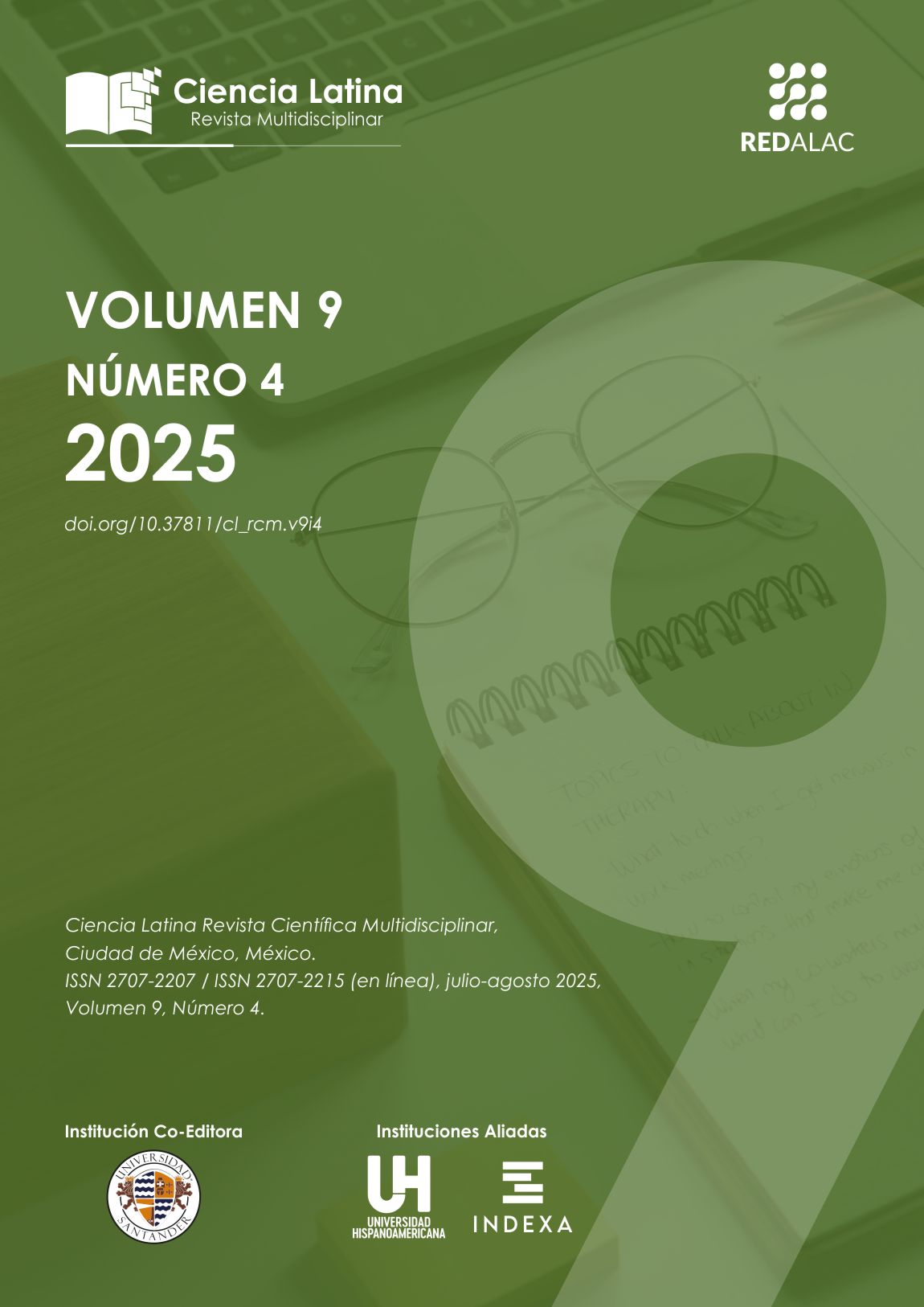Determinación de la concentración mínima inhibitoria de ciprofloxacino en presencia de ácido gálico contra E. coli, in vitro
Resumen
El uso excesivo e irresponsable de antibióticos es una de las principales causas de la resistencia bacteriana como la mostrada por Escherichia coli, lo cual se traduce en uno de los principales problemas de salud pública a nivel mundial representando un alto grado de ineficiencia en los tratamientos contra este tipo de bacterias. Para este estudio se determinaron las concentraciones mínimas inhibitorias de ciprofloxacino y ácido gálico (GA), este último, es un metabolito secundario presente en una gran variedad de plantas y productos naturales. Se combinaron ambos compuestos mediante el método de macrodilución en caldo según el documento Clinical and Laboratory Standards Institute (CLSI) M07-A10 y se llevó a cabo un análisis espectrofotométrico a una longitud de onda de 560 nm. Se evaluaron diferentes concentraciones, 0.25, 0.5, 1, 2, 4 µg/ml para ciprofloxacino y 350, 700 y 1400 µg/ml para ácido gálico. Las concentraciones mínimas inhibitorias (CMI) resultantes fueron de 2 µg/ml para ciprofloxacino y 350 µg/ml para ácido gálico, y para la combinación de ambos fue de 1 µg/ml y 350 µg/ml respectivamente. Demostrando que el efecto antibacteriano del antibiótico se ve aumentado por sinergismo con el GA, disminuyendo la CMI del mismo. Se puede concluir que la combinación de ciprofloxacino y GA puede ser una alternativa prometedora para combatir la resistencia antibacteriana mostrada por Escherichia coli ATCC 25922 frente al ciprofloxacino, sin embargo, se requieren estudios más específicos antes de poder aplicarse a la farmacoterapia clínica..
Descargas
Citas
Andrews, J. M. (2001). Determination of minimum inhibitory concentrations. The Journal of antimicrobial chemotherapy, (48) Suppl 1, 5–16. https://doi.org/10.1093/jac/48.suppl_1.5
Alencar, F. F. H. and Nunes, S.H.R. (2016). Gallic Acid: Review of the Methods of Determination and Quantification. Crit Rev Anal Chem. 3;46(3):257-65. doi: 10.1080/10408347.2015.1095064. https://pubmed.ncbi.nlm.nih.gov/26440222/.
Badhani, B., Sharma, N. et Kakkar, R. (2015). Gallic acid: a versatile antioxidant with promising therapeutic and industrial applications. RSC Advances, 5(35), 27540‑27557. https://doi.org/10.1039/C5RA01911G
Bai, Z-Z., Ni, J., Tang, J-M., Sun, D-Y., Yan, Z-G., Zhang, J., Niu, L-X., Zhang, Y-L. (2020). Bioactive Components, Antioxidant and Antimicrobial Activities of Paeonia Rockii Fruit during Development, Food Chemistry, 1(343), 128444. doi: https://doi.org/10.1016/j.foodchem.2020.128444
Bustos, P., Berale, G., Cabrera, J.L. y Ortega, M.G. (2019). Efecto modulador de luteolina y quercetina sobre la actividad superóxido dismutasa alterada por ciprofloxacina y cloranfenicol en leucocitos humanos. [Jornadas] XXII Jornadas Científicas. Sociedad de Biología de Córdoba. Argentina. https://ri.conicet.gov.ar/handle/11336/140285
Chávez-Jacobo, Víctor M., Ramírez-Díaz, Martha I., Silva-Sánchez, Jesús, & Cervantes, Carlos. (2015). Resistencia Bacteriana a Quinolonas: Determinantes Codificados en Plásmidos. REB. Revista de educación bioquímica, 34(1), 4-9. Recuperado en 23 de julio de 2025, de http://www.scielo.org.mx/scielo.php?script=sci_arttext&pid=S1665-19952015000100004&lng=es&tlng=es.
CLSI, M07 ed12. Methods For Dilution Antimicrobial Susceptibility Tests for Bacteria that Grow Aerobically; 12th Edition.2015. CLSI M07-A10. Wayne, PA: Clinical and Laboratory Standards Institute.
CLSI Performance Standard for Antimicrobial Susceptibility Testing. 30th ed. CLSI supplement M100 Wayne , PA; Clinical and LaboratoryStandards Institute; 2020
Daglia, M., Di Lorenzo,A., Nabavi, S. F., Talas,Z.S., Nabavi, S. M.( 2014). Polyphenols: well beyond the antioxidant capacity: gallic acid and related compounds as neuroprotective agents: you are what you eat. Curr Pharm Biotechnol.15(4):362-72. doi: 10.2174/138920101504140825120737. https://pubmed.ncbi.nlm.nih.gov/24938889/!
Friedman, S.M., Lu, T., Drlica, K. (2001). Mutation in the DNA gyrase A gene of Escherichia coli that expands the quinolone resistance-determining region. Antimicrob Agents Chemoter, 45(8), 2378–2380. https://doi.org/10.1128/AAC.45.8.2378-2380.2001
Fadare, F. T., Elsheikh, E. A. E., & Okoh, A. I. (2022). In Vitro Assessment of the Combination of Antibiotics against Some Integron-Harbouring Enterobacteriaceae from Environmental Sources. Antibiotics (Basel, Switzerland), 11(8), 1090. https://doi.org/10.3390/antibiotics11081090
Hemaiswarya, S., Kruthiventi, A. K., & Doble, M. (2008). Synergism between natural products and antibiotics against infectious diseases. Phytomedicine : international journal of phytotherapy and phytopharmacology, 15(8), 639–652. https://doi.org/10.1016/j.phymed.2008.06.008
Horna Quintana, Gertrudis, Silva Díaz, María, Vicente Taboada, William, & Tamariz Ortiz, Jesús. (2005). Concentración mínima inhibitoria y concentración mínima bactericida de ciprofloxacina en bacterias uropatógenas aisladas en el Instituto Nacional de Enfermedades Neoplásicas. Revista Medica Herediana, 16(1), 39-45. Recuperado en 17 de julio de 2025, http://www.scielo.org.pe/scielo.php?script=sci_arttext&pid=S1018-130X2005000100007&lng=es&tlng=es.
Hossain, M.A., Park, H.-C., Park, S.-W., Park, S.-C., Seo, M.-G., Her, M. y Kang, J. (2020). Sinergismo de la combinación de antibióticos tradicionales y nuevos compuestos fenólicos contra Escherichia coli. Pathogens , 9 (10), 811. https://doi.org/10.3390/pathogens9100811
Jayaraman, P., Sakharkar, M. K., Lim, C. S., Tang, T. H., Sakharkar, K. R. (2010). Activity and interactions of antibiotic and phytochemical combinations against Pseudomonas aeruginosa in vitro. Int J Biol Sci.;6(6):556-68. doi: 10.7150/ijbs.6.556. PMID: 20941374; PMCID: PMC2952406.
Kang, J., Li, Q., Liu, L. et al. (2018). The specific effect of gallic acid on Escherichia coli biofilm formation by regulating pgaABCD genes expression. Appl Microbiol Biotechnol 102, 1837–1846. https://doi.org/10.1007/s00253-017-8709-3
Keyvani-Ghamsari, S., Rahimi, M., & Khorsandi, K. (2023). An update on the potential mechanism of gallic acid as an antibacterial and anticancer agent. Food Science & Nutrition, 11, 5856–5872. https://doi.org/10.1002/fsn3.3615
Kim T., J. Silva and Jung,Y. (2009). Antibacterial activity of fresh and processed red muscadine juice and the role of their polar compounds on Escherichia coli O157:H7. Journal of Applied Microbiology 107: 533-539
Mabe K., Yamada, M., Oguni, I. and Takahashi T. (1999). In vitro and in vivo activities of tea catechins against Helicobacter pylori. Antimicrobial Agents and Chemotherapy 43 (7): 1788-1791. https://doi.org/10.1128/AAC.43.7.1788
Manach C., G. Williamson, C. Morand, A. Scalbert and C. Rémésy. 2005. Bioavailability and bioefficacy of polyphenols in humans. I. Review of 97 bioavailability studies. The American Journal of Clinical Nutrition 81 (1 Suppl), 230S–242S. https://doi.org/10.1093/ajcn/81.1.230S
Mandal, J., Acharya, N. S., Buddhapriya, D., & Parija, S. C. (2012). Antibiotic resistance pattern among common bacterial uropathogens with a special reference to ciprofloxacin resistant Escherichia coli. The Indian journal of medical research, 136(5), 842–849.
Matta-Chuquisapon J., Valencia-Bazalar E., Sevilla-Andrade C., Barrón-Pastor H. J. (2022). Filogenia y resistencia antimicrobiana de cepas de Escherichia coli productoras de betalactamasas de espectro extendido en pacientes con cáncer hospitalizados en Perú. Biomédica. 42 470-8. https://doi.org/10.7705/biomedica.6263
Montejano Rodríguez, J. R., Almaguer Vargas, G., García Ortiz, E. P., Mora Martínez , M., Becerril Flores, M. A., & Ruiz Anaya, M. E. (2024). Potenciación del efecto antibiótico de Ciprofloxacino en presencia de ácido gálico Vs Escherichia coli. Revista de Ciencia Latina Revista Científica Multidisciplinar, 8(5), 453-475. https://doi.org/10.37811/cl_rcm.v8i5.13325
Oliphant CM, Green GM. Quinolones: a comprehensive review. Am Fam Physician.(2002 );65(3):455-64. PMID: 11858629.
Rodríguez, V. M. J. Alberto, M. R., Manca de Nadra M. C. (2005). Antibacterial effect of phenolic compounds from different wines. Food Control 18 93-101. https://ri.conicet.gov.ar/bitstream/handle/11336/53997/CONICET_Digital_Nro.271b0af2-8249-4412-8885-badf525bb5dc_A.pdf?sequence=2&isAllowed=y
Rodriguez, L. M., Ruiz, N. Sangoi, D., Guerrero, A.M., Ciangherotti, C., Bermudez, J., Araujo, M. L. Israel, A. y Bor, M. (2023). Efecto comparativo de la actividad antioxidante del Ácido Gálico y diferentes Alquigalatos. Revista Facultad de Farmacia, UCV. http://saber.ucv.ve/ojs/index.php/rev_ff/article/view/26847/144814492719
Sánchez, J. M. and Guillán, C. (2003). Sensibilidad Microbiana de Escherichia coli en Infecciones Urinarias extrahospitalarias. Actas Urol Esp;27(10):783-787.Recuperado el 23 de julio de 2025, de http://scielo.isciii.es/scielo.php?script=sci_arttext&pid=S0210-48062003001000003&lng=es&tlng=es.
Smith A., J. Imlay and R. Mackie. (2003). Increasing the oxidative stress response allows Escherichia coli to overcome inhibitory effects of condensed tannins. Applied and Environmental Microbiology 69 (6): 3406–3411. https://doi.org/10.1128/AEM.69.6.3406-3411.2003
Tian, Q., Wei, S., Su, H., Zheng, S., Xu, S., Liu, M., Bo, R., & Li, J. (2022). Bactericidal activity of gallic acid against multi-drug resistance Escherichia coli. Microbial pathogenesis, 173(Pt A), 105824. https://doi.org/10.1016/j.micpath.2022.10582
Tiwana G, Cock IE, Cheesman MJ. (2024). Combinations of Terminalia bellirica (Gaertn.) Roxb. and Terminalia chebula Retz. Extracts with Selected Antibiotics Against Antibiotic-Resistant Bacteria: Bioactivity and Phytochemistry. Antibiotics (Basel). 13(10):994. doi: 10.3390/antibiotics13100994.
O’Gara E., D. J. Hill and D. J. Maslin. (2000). Activities of garlic oil, garlic powder, and their diallyl constituents against Helicobacter pylori. Applied and Environmental Microbiology 66 (5): 2269-2273 . https://doi.org/10.1128/AEM.66.5.2269-2273.200
OMS (2017). Un informe de la OMS confirma que el mundo se esta quedando sin antibióticos Comunicado de prensa OMS recuperado el 23 de junio del 2025 https://www.who.int/es/news/item/20-09-2017-the-world-is-running-out-of-antibiotics-who-report-confirms
Vattem D., Y. Lin, R. Ghaedian and K. Shetty.(2005). Cranberry synergies for dietary management of Helicobacter pylori infections. Process Biochemistry 40: 1583-1592 https://doi.org/10.1016/j.procbio.2004.06.024
Torres V. E. S., Mendivil D. J. A., Pertuz M. Y., Rojas G. A. C.(2025). Nueve años de tendencia en la resistencia a ciprofloxacina por Escherichia coli: estudio transversal en un hospital de Colombia. Cadernos de Saúde Pública [online]. 40:7 e00031723.. Disponible en: <https://doi.org/10.1590/0102-311XES031723>. ISSN 1678-4464.
Villalobos, E. S. T., Ossa, J. A. M., Meza, Y. P., & Gulloso, A. C. R. (2024). Nueve años de tendencia en la resistencia a ciprofloxacina por Escherichia coli: estudio transversal en un hospital de Colombia [Nine-year trend in Escherichia coli resistance to ciprofloxacin: cross-sectional study in a hospital in Colombia]. Cadernos de saude publica, 40(7), e00031723. https://doi.org/10.1590/0102-311XES031723
Wamba BEN, Nayim P., Mbaveng A.T., Voukeng I.K., Dzotam J.K., Ngalani O.J.T., Kuete V. (2018). Syzygium jambos displayed antibacterial and antibiotic-modulating activities against resistant phenotypes. Evid Based Complement Alternat Med. 2018:5124735. https://doi.org/10.1155/2018/5124735
World Health Organization. Antimicrobial resistance: global report on surveillance. Ginebra: World Health Organization; 2014.Recuperado el día 23 de junio del 2025 de https://www.who.int/publications/i/item/9789241564748
World Health Organization. The selection and use of essential medicines: report of the WHO Expert Committee, 2020 (including the 20th WHO Model List of Essential Medicines and the 6th WHO Model List of Essential Medicines for Children). Geneva World Health Organization; 2017. (WHO Technical Report Series, No. 1006).ISBN: 978-92-4-121015-7. Recuperado el día 21 de junio del 2025 de: https://www.who.int/publications/i/item/9789241210157
WHO Europe Antimicrobial resistance Resistance in bacteria 19 september 2024 Newsroom Recuperado el día 21 de junio del 2025 de: https://www.who.int/europe/news-room/fact-sheets/item/antimicrobial-resistance
Yoon, S.H., Jeong, H., Kwon, SK., Kim, J.F. (2009). Genomics, Biological Features, and Biotechnological Applications of Escherichia coli B: “Is B for better?!”. In: Lee, S.Y. (eds) Systems Biology and Biotechnology of Escherichia coli . Springer, Dordrecht. https://doi.org/10.1007/978-1-4020-9394-4_1
Zambuchini, B., D. Fiorini, M.C. Verdenelli, C. Orpianesi, R. Ballini. (2008). Inhibition of microbiological activity during sole (Solea solea L.) chilled storage by applying ellagic and ascorbic acids. LWT - Food Science and Technology 41: 1733-1738. https://doi.org/10.1016/j.lwt.2007.11.00
Zhang, G. F., Liu, X., Zhang, S., Pan, B., & Liu, M. L. (2018). Ciprofloxacin derivatives and their antibacterial activities. European journal of medicinal chemistry, 146, 599–612. https://doi.org/10.1016/j.ejmech.2018.01.078
Añapa Quiñónez, P. L., Recalde Páez, J. P., Fey Zalamea, C. D., Rivera Quiñónez, E. D., & Acuri Pacheco, D. A. (2025). Estrategias para la Implementación Efectiva del Aprendizaje Híbrido (Blended Learning) en Instituciones Educativas Rurales del Ecuador: Un Análisis Integral. Ciencia Y Reflexión, 4(2), 1160–1184. https://doi.org/10.70747/cr.v4i2.325
Agila Mocha, R. J., Vivanco Ureña, C. I., León Bravo, F. E., & Reyes Carrión , J. P. (2025). Software Educativos para el Proceso de Enseñanza Aprendizaje de Matemáticas en Bachillerato. Ciencia Y Reflexión, 4(2), 1341–1369. https://doi.org/10.70747/cr.v4i2.334
Chen Shih , J. (2025). Relación entre inteligencia emocional y rendimiento académico en estudiantes de nivel superior de Arequipa en la postpandemia . Ciencia Y Reflexión, 4(2), 648–667. https://doi.org/10.70747/cr.v4i2.299
Derechos de autor 2025 Adán Abel González Hernández , Georgina Almaguer Vargas, José Ramón Montejano Rodríguez, Erika Paulina García Ortiz, Marco Antonio Becerril Flores, Rubén Israel Ambriz Curiel, Valeria Aguilar Gutiérrez

Esta obra está bajo licencia internacional Creative Commons Reconocimiento 4.0.











.png)




















.png)
1.png)


